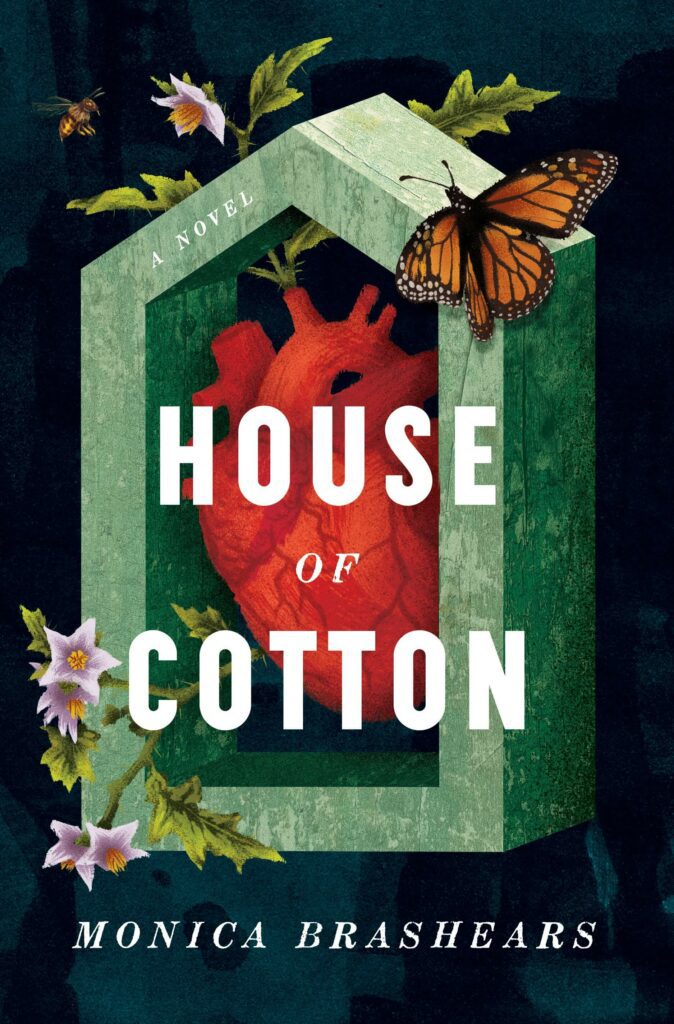
HALFWAY THROUGH MONICA Brashears’s debut House of Cotton, the narrator, Magnolia, observes, “Grief makes people slapstick.” Until then, I wasn’t entirely sure what sort of novel I was reading. The story is told by a young woman who takes a very strange job in a funeral parlor during a down-and-out period of poverty, loss, and sexual compulsion. With its Brothers Grimm epigraphs, leitmotif of fairy tale references, and folksy-profane vernacular, the book’s narrative surface has a timeless and fantastical quality. The images are drawn from the natural world, lovely and gritty: “a crescent moon, skinny as a nail clipping,” a character who “breathed and talked like a June thunderstorm,” walls “dense as pound cake.”
The title suggests a Southern Gothic. Yet many of the situations are hyper-contemporary—Magnolia (Carolina on her Tinder profile) has a series of plein-air assignations that set up razor sharp one-liners, observations of the world we live in now. A purple hybrid car disgorges “[a] guy with shaggy hair… pale skin marked with stick-and-poke tattoos” who “grunts like he’s annoyed he paused Wes Anderson for this.” Brashears, who identifies as Affrilachian and holds an MFA from Syracuse, also does good work with objects. Magnolia works at a gas station; its moniker, the People’s Gas Station, gives it a symbolic aura, but the stuff on the shelves is real gas station Americana—Pabst, MoonPies, apple juice. This is a novel that uses Sephora as a location. At one point, Magnolia enters the familiar makeup emporium and acquires a bottle of Chanel “so I can smell like a drowsy bouquet whenever I please.”
A drowsy bouquet! I mean, isn’t that just exactly right? Another bravura description, this one of a police station: “This place blinding and sleepy all at once, like I’m in a hospital. Instead of rubbing alcohol and latex, I smell boiled eggs and burnt coffee. But I guess both places got the grim reaper lurking in their walls.”
And yet, I’m not sure all Brashears’s fine sentences would hang together without the “slapstick” sensibility which emerges from its overwhelming grief. The novel opens with the funeral of Mama Brown, the only person who has protected and seen Magnolia. Magnolia is possibly pregnant. She’s scrambling for rent money; she may soon lose her grandmother’s home. Her white mother is an absentee parent (that’s the charitable version) and drug addict. The only living person Magnolia does seem to care about is Cigarette Sammy, who got his nickname searching for butts in the trash and is said to have gone off on some synthetic weed—more likely a source of heartbreak than of mutual support. To put it mildly, Magnolia Brown is having a hell of a life.
House of Cotton is populated by creeps and spirits and the dead refusing to stay dead. It is about racism and poverty and sexual violence. And yet, it is also very funny. A dead girl’s mouth is described as “round enough to deepthroat a lamp.” At one point, Magnolia mentions “That bare-knuckled fight with the waist trainer.” In a hotel lobby, over one of those pointless desktop fountains, three characters call-and-response TLC’s “Waterfalls.”
The dead are prone to all the foibles of the living.
Even the villains, while sinister, are ridiculous. The titular Cotton is the owner of a funeral home, an entrepreneur of the macabre, a character who enters the novel with literal blood on his hands and is revealed to have something of a corpse fetish (“Horny about profit and death”). Cotton’s aunt, Eden, is a true sot who could teach the Kardashian sisters a few things about makeup. One night, Eden, taking the piss, tells Magnolia about numerous dried boogers she once discovered behind her nephew’s childhood bed. Eden recalls: “Cotton said, ‘Aunt Eden, that’s my collection.’” To which Magnolia quips: “Call you boogeyman.”
The novel’s sense of humor, as well as its handling of the supernatural, reminded me of Hilary Mantel’s talking-to-spirits masterpiece Beyond Black. Part of that novel’s genius is to portray the dead as unreliable and banal, their “perfidy… their selfish, trivial outlook.” At the same time, Mantel fully commits to describing the physical actuality of the dead, “their partial, penetrative nature, their way of dematerializing and leaving bits of themselves behind, or entangling themselves with your inner organs.” Brashears similarly commits, making the ghost of Mama Brown viscerally present on the page. Magnolia describes smelling her “stench of moth balls and shit and cabbage gone bad.” During one scene, Mama Brown “stretches her legs out on the bed. A maggot pokes out a sore in her knee, burrows deeper.” In House of Cotton, the dead are prone to all the foibles of the living—“spirits are gossipy as robins,” observes one character. And yet the world of this novel is strange enough that Magnolia’s sensitivity to the spirit realm, to all the forces at work beyond our observable reality, is satisfying in concrete terms, as well as a satisfying metaphor for traumas historical and personal.
HOW DID MAGNOLIA fall in with these sketchy white people, Cotton and Eden? The novel is at pains to show her desperate situation—piling on the emotional and financial complications that make Cotton’s offer of a “modeling” job a plausible temptation. The modeling turns out to be a specialized service Cotton has dreamed up, “a way to help people in particular circumstances find closure in a particular manner.” (Cotton, who comes from family money, spent time in New York, and is excited about getting a write up in Vice, has a colonizer’s gift for euphemism.) The service is a Skype session with Magnolia, heavily made up to resemble a lost loved one, performing a dead daughter, wife, or lover for the bereaved. Cotton is the maestro/pimp, creating the mise-en-scène, collecting the money. Eden is a master of contouring—a “cosmetic savant,” in Cotton’s words. (One of the novel’s running gags is that Eden has a Meryl Streep face one day, Sigourney Weaver the next.) Cotton describes Magnolia’s role as “lady palimpsest.” Things never really seem above board here, but Magnolia goes with it for the money, living in the funeral parlor, doing a job that is increasingly weird and perilous.
Magnolia’s is a bildungsroman arc—from self-abasement to the beginnings of awakening. This is one aspect of the novel that did not, in my reading, live up to its ambition. Magnolia starts off in bad shape, and she gets into business with a slick man who seems unlikely to be interested in her well-being. The scene that proves Cotton’s true nature is a tour de force, but it is not a surprise. In life, we often enter bad situations knowing the outcome, and leave unsurprised, if a little more broken. But those experiences tend to have a time-bending effect. The three-act structure employed here, the rising and falling action, the compressed linear timeline—all of that loses air when the crisis is foretold. I could see many classic creative writing adages at work: put your character under as much pressure as possible, force them to change. Magnolia does change, but I felt I hadn’t known her or her world long enough to understand why.
Brashears takes another of the book’s epigraphs from Toni Morrison’s Sula: “I don’t want to make somebody else. I want to make myself.” Reading House of Cotton, I thought of the ways Morrison handles time in her early novels with young protagonists—making great leaps, jumping around, bringing in multiple points of view, inventing a structure to suit the subject. I wondered if Magnolia’s story would have been better served by a less conventional chronology. But this is a quibble. Brashears’s voice is literary lightning. That Morrison quote is realized with a remarkable visual reversal that I will not spoil. You must read the whole novel to feel its perfection. It’s an image that is going to be in my mind’s eye a long time.

